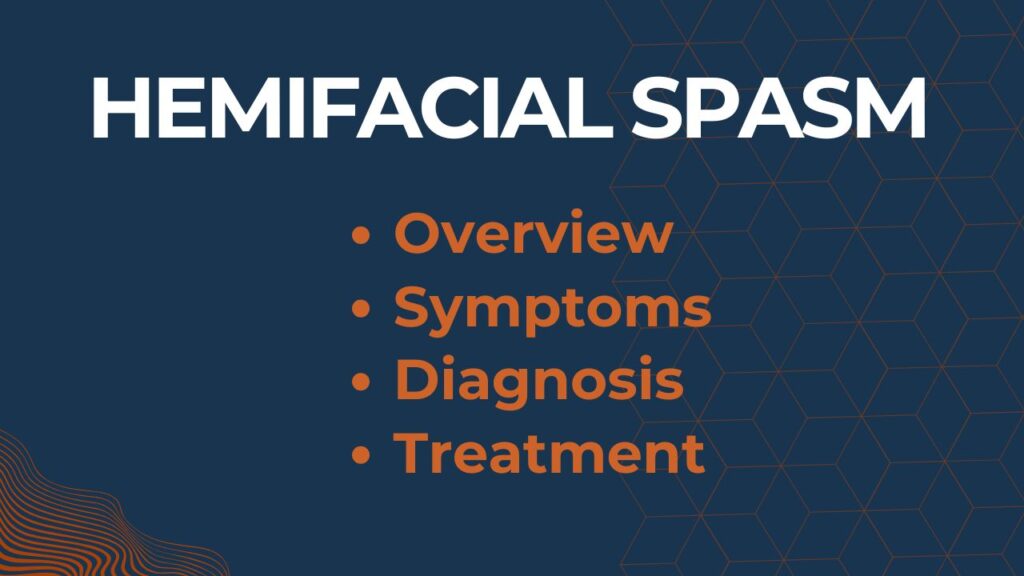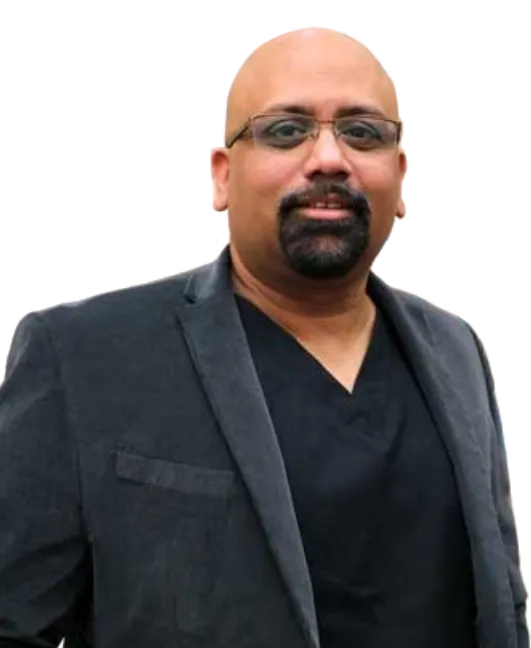Hemifacial Spasm
Hemifacial Spasm | Conditions, Symptoms, Diagnosis, Treatment and Best Options and Best Surgeon Doctor for Hemifacial Spasm Treatment in Pune
Imagine an involuntary twitching of one side of your face, starting subtly around the eye, then gradually spreading to affect your cheek, mouth, and even your neck. This persistent, uncontrollable muscle contraction, which can intensify under stress or fatigue, is the defining characteristic of Hemifacial Spasm (HFS). While not typically painful like Trigeminal Neuralgia, HFS can be incredibly embarrassing, disabling, and significantly impact a person’s quality of life, affecting their social interactions, work, and mental well-being.
For individuals seeking relief from this involuntary facial twitching, expert neurosurgical intervention offers a profound difference. In Pune, India, Dr. Jaydev Panchwagh, a globally recognized neurosurgeon with unparalleled experience in Microvascular Decompression (MVD) surgery, provides definitive and lasting solutions for Hemifacial Spasm, helping patients regain control over their facial expressions and their lives.

What is Hemifacial Spasm?
Hemifacial Spasm is a neuromuscular disorder characterized by involuntary twitching or spasms of the muscles on one side of the face. “Hemi” means half, and “facial” refers to the face, indicating that it affects only one side.
The facial muscles are controlled by the facial nerve (7th cranial nerve). Similar to Trigeminal Neuralgia, the most common cause of Hemifacial Spasm is the compression of the facial nerve by a nearby blood vessel (usually an artery, sometimes a vein) where the nerve exits the brainstem.
The continuous pulsation of this vessel against the nerve over time irritates and damages its outer covering (myelin sheath). This damage causes the nerve to fire off abnormal, spontaneous signals, leading to the involuntary muscle contractions.
Less common causes can include facial nerve injury, a tumor pressing on the facial nerve, or, rarely, conditions like multiple sclerosis. Dr. Jaydev Panchwagh emphasizes that understanding the root cause is crucial for effective treatment, and in the vast majority of cases, it’s the vascular compression that needs to be addressed.
- Symptoms
- Causes and Risk
- Diagnosis
- Treatment
The symptoms of Hemifacial Spasm develop gradually and almost always affect only one side of the face. As explained by Dr. Jaydev Panchwagh and detailed on sites like neurosurgerypune.com:
- Initial Twitching: It typically begins with a subtle, intermittent twitching of the eyelid or around the eye (orbicularis oculi muscle).
- Progressive Spread: Over time, the spasms progressively spread downwards to involve other muscles on the same side of the face, including the cheek, around the mouth (e.g., pulling the corner of the mouth), and sometimes even the platysma muscle in the neck.
- Involuntary and Uncontrollable: The spasms are entirely involuntary, meaning the patient cannot control them.
- Variable Intensity: The severity and frequency of the spasms can vary. They often become more noticeable and frequent with stress, fatigue, anxiety, bright lights, or even talking and smiling.
- Presence During Sleep: Some patients may experience these spasms even during sleep, and some may have a disturbed sleep because of them.
- No Pain (Usually): Unlike Trigeminal Neuralgia, Hemifacial Spasm is generally not painful, although some patients may experience a pulling sensation or mild discomfort due to continuous muscle contractions. Many patients, especially those with severe hemifacial spasms, report facial fatigue caused by constant muscle overactivity.
The constant twitching can lead to significant functional and cosmetic issues, impacting vision (if the eye repeatedly closes), eating, speaking, and leading to considerable social anxiety and emotional distress.
As mentioned, the overwhelming majority of Hemifacial Spasm cases are caused by compression of the facial nerve by an aberrant blood vessel (artery or vein) at its exit zone from the brainstem. The pulsating vessel causes chronic irritation and demyelination (damage to the nerve’s protective sheath), leading to abnormal electrical signals.
Other less common causes or contributing factors include:
- Facial Nerve Injury: Previous trauma or injury to the facial nerve.
- Tumors: Very rarely, a tumor in the cerebellopontine angle (CPA) region may cause facial nerve compression directly or indirectly.
- Multiple Sclerosis (MS): In rare instances, HFS can be a symptom of MS.
- Aneurysms or Arteriovenous Malformations (AVMs): In extremely rare cases, a vascular anomaly other than a normal blood vessel might cause facial nerve compression.
Age is also a factor, as HFS typically begins in middle to older age, likely because blood vessels can become more tortuous and stiff with aging, increasing the likelihood of nerve contact.
Diagnosing Hemifacial Spasm: It is primarily a clinical diagnosis based on the characteristic symptoms reported by the patient. Dr. Jaydev Panchwagh emphasizes a meticulous review of the patient’s history and a thorough examination:
- Detailed Medical History and Symptom Assessment: The neurosurgeon will carefully listen to the patient’s description of the twitching, including its onset, progression, triggers, and impact on daily life. Observing the spasms during the consultation is often highly diagnostic.
- Neurological Examination: A comprehensive exam to assess facial nerve function, identify any associated weakness or numbness, and rule out other neurological conditions.
- Imaging Tests (MRI): An MRI of the brain, specifically with sequences designed to visualize the facial nerve and surrounding structures (like high-resolution FIESTA or CISS sequences), is crucial. This specialized MRI helps to:
- Confirm Vascular Compression: It can often identify the specific blood vessel compressing the facial nerve, providing direct evidence for the most common cause.
- Rule Out Other Causes: It is vital to exclude less common causes such as a tumor, cyst, or multiple sclerosis lesion that might be compressing the nerve.
- Aid Surgical Planning: If Microvascular Decompression (MVD) is being considered, the MRI provides precise anatomical details for the surgeon.
While Electrography (EMG) or nerve conduction studies might be performed in some cases to confirm nerve dysfunction, the clinical picture combined with a high-resolution MRI is usually sufficient for accurate diagnosis.
The goal of Hemifacial Spasm treatment is to stop the involuntary spasms and improve the patient’s quality of life. Treatment options range from temporary solutions to a potentially permanent cure, with Dr. Jaydev Panchwagh advocating for the most effective long-term solution based on his extensive experience.
- Medication: (Limited Use*)
- Oral Medications: Anticonvulsant medications (like Carbamazepine, Clonazepam, Gabapentin) or muscle relaxants (like Baclofen) are sometimes prescribed to help reduce the severity or frequency of spasms.
- Limitations: While they may offer some initial relief, they often have limited long-term efficacy, requiring increasing doses which can lead to significant side effects such as drowsiness, dizziness, and cognitive impairment. Medications do not address the underlying cause.
- Botulinum Toxin (Botox) Injections: (Limited Use*)
- Temporary Relief: Botox injections are a very common treatment. Small amounts of Botox are injected into the affected facial muscles, temporarily paralyzing them and stopping the spasms.
- Limitations: The effect is temporary, typically lasting for 3-6 months, after which repeat injections are necessary. It addresses the symptom (muscle contraction) but not the underlying cause (nerve compression). Over time, repeated injections can lead to facial weakness or asymmetry.
- Surgical Option (Best Option for potentially Permanent Cure):
- Microvascular Decompression (MVD) Surgery:
- The Gold Standard and Potentially Curative: MVD is the definitive and most effective long-term treatment, often offering a permanent cure for Hemifacial Spasm. Dr. Jaydev Panchwagh is a globally recognized authority in MVD surgery, having performed over 2900 MVD procedures for both Trigeminal Neuralgia and Hemifacial Spasm, positioning his center as a “Centre of Excellence” for these conditions.
- How it Works: Similar to MVD for Trigeminal Neuralgia, this highly specialized neurosurgical procedure is performed under a high-power operating microscope. A small opening is made behind the ear. Dr. Panchwagh then carefully identifies the blood vessel (usually an artery) that is compressing the facial nerve at its exit from the brainstem. This vessel is gently moved away from the nerve, and a small, inert, permanent Teflon sponge is inserted between them to keep them separated, thereby relieving the pressure and allowing the nerve to heal. Where anatomically possible a sling may also be created to change the direction of the blood vessel.
- Benefits: MVD aims to address the root cause of the problem. It offers immediate or rapid relief from spasms in a very high percentage of patients (often over 90-95%) with a high success rate for long-term or permanent resolution. Crucially, it preserves facial nerve function, minimizing the risk of permanent facial weakness or paralysis, and allows patients to potentially stop medication. Dr. Panchwagh’s extensive experience significantly contributes to the high success rates and patient satisfaction.
- Microvascular Decompression (MVD) Surgery:
*Limited Use: This indicates a potentially temporary solution, and after the treatment, there is a higher chance of symptom or disease recurrence.
Watch this Video to Know More about Hemifacial Spasm
Why Choose Dr. Jaydev Panchwagh for Hemifacial Spasm Treatment?
For individuals seeking a lasting solution for Hemifacial Spasm, Dr. Jaydev Panchwagh represents the pinnacle of neurosurgical expertise in India:
- Unrivaled MVD Experience: With one of the largest single-surgeon series of over 2900 MVD procedures for HFS and Trigeminal Neuralgia, Dr. Panchwagh’s mastery of this complex surgery is virtually unmatched. This extensive experience has contributed to achieving consistent, successful outcomes.
- Focus on Permanent Resolution: He prioritizes MVD as the best opportunity for a potentially permanent cure by addressing the underlying cause of the spasm, freeing patients from the ongoing need for temporary and painful treatments like Botox injections or the side effects of oral medications.
- Precision and Safety: His use of high-standard operating microscopes, combined with meticulous surgical technique, ensures maximal safety and preservation of facial nerve function during the delicate MVD procedure.
- International Recognition: Patients from across India and numerous countries worldwide seek his specialized care for Hemifacial Spasm, underscoring his global reputation as a leader in this field.
- Holistic Patient Care: Dr. Panchwagh and his dedicated team provide comprehensive support, from detailed pre-operative counseling to meticulous post-operative care, guiding patients through every step of their journey to recovery.
Educational Commitment: Through initiatives like the Synapse Brain and Spine Foundation, Dr. Panchwagh actively educates patients and the public about HFS and its effective treatments.
Frequently Asked Questions (FAQs) about Hemifacial Spasm
Typically, Hemifacial Spasm affects only one side of the face. While very rare, some conditions might cause bilateral facial spasms, but mostly Hemifacial Spasm remains unilateral.
All surgeries carry some risks. However, with Dr. Jaydev Panchwagh’s vast experience and advanced microsurgical techniques, the risks associated with MVD for HFS are significantly minimized. Potential risks and benefits are thoroughly discussed with the patient.
Many patients experience immediate cessation of spasms after MVD surgery. For some, the spasms may gradually decrease in intensity and frequency over several weeks or months, as the nerve heals.
Yes, when MVD surgery successfully resolves the spasms, you will no longer need Botox injections. Dr. Panchwagh’s goal is to free patients from the need for continuous treatments.
Reclaim Your Facial Control and Confidence
Hemifacial Spasm can be a source of significant distress, but it is a treatable condition with a high potential for a permanent cure. Dr. Jaydev Panchwagh offers the expertise and advanced solutions to help you regain control over your facial expressions and improve your quality of life.

A distinguished Brain and Spine Surgeon, shaping neurosurgical care in Pune, Maharashtra, India for over two decades.
Quick Link

Quick Contacts
- Phone : (+91) 9011333841 , (+91) 7720948948
- brainspine66@gmail.com
- 102, Bhagyatara Society, 1st floor, Mehendale Garage road, Erandwane, Pune
Map
- Copyright @2025 | Dr. Jaydev Panchwagh | Praavi Medicare
